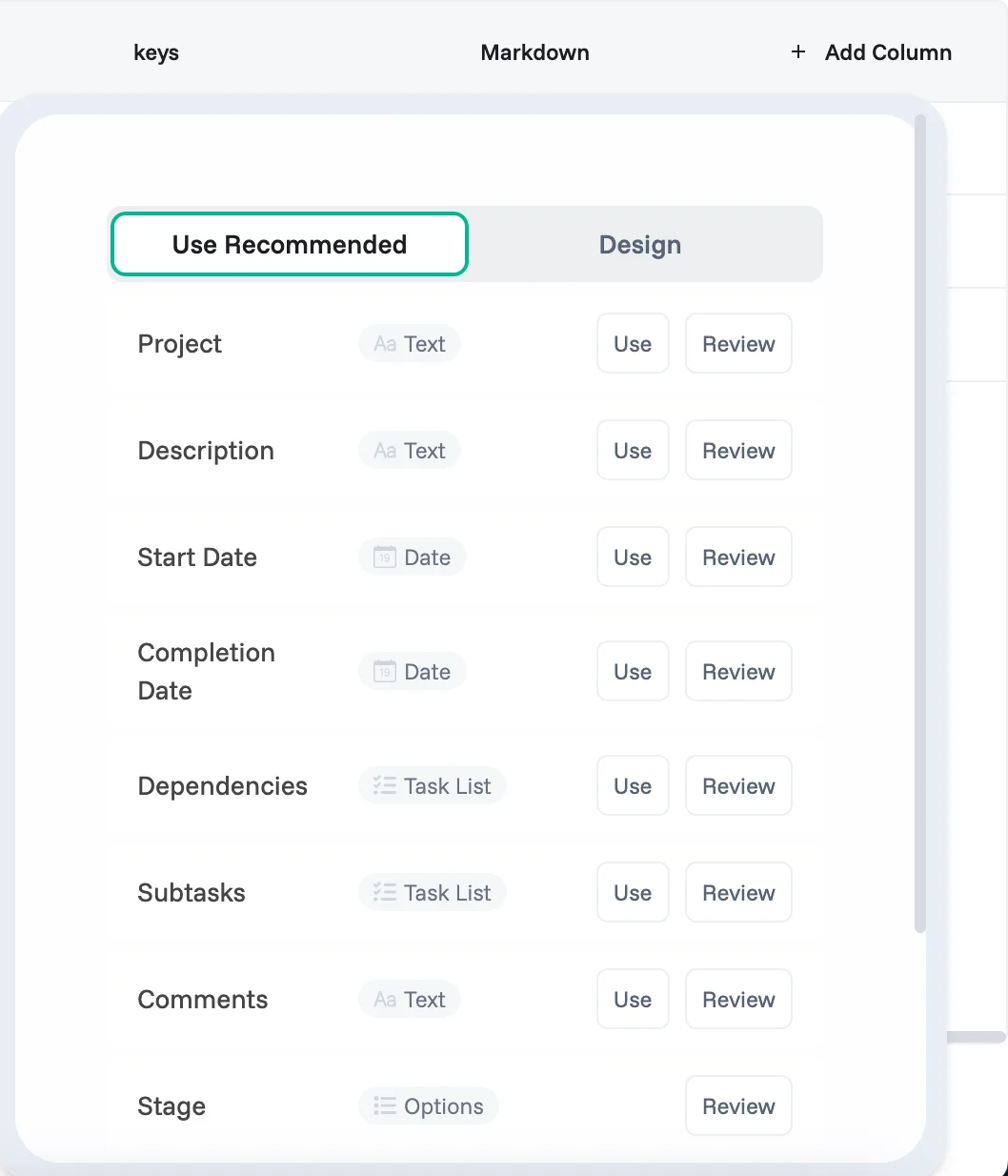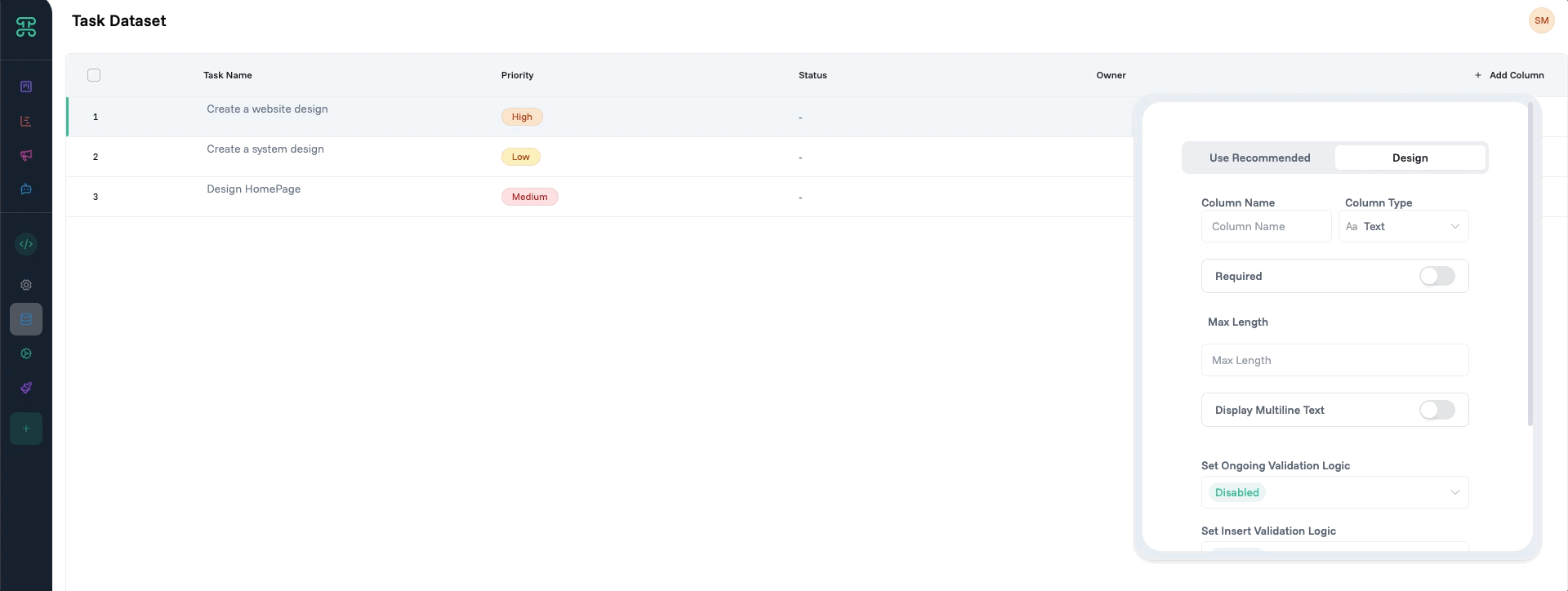Introduction
Traditional spreadsheets and databases treat every field the same way—just empty boxes waiting for someone to type something in. But real business data has meaning and relationships. An approval isn't just text saying "approved"—it needs the right person's authorization at the right time. A payment isn't just a number—it's a complete transaction flow with providers, amounts, and confirmations. An address isn't just a string—it needs validation, components, and geographic coordinates.
When you force complex business processes into simple text and number fields, you end up building elaborate workarounds, maintaining separate tracking spreadsheets, and relying on everyone to remember the right procedures. Smart Columns change this entirely by embedding intelligence directly into your data structure. Need formal approvals? Add an Approval column that knows who can approve and when. Processing payments? The Payment column handles the entire flow. Building quotes? The Cart column manages item selection and calculations. Instead of cobbling together basic fields and hoping people follow the process, Smart Columns give you purpose-built components that understand and enforce your business logic automatically, turning your data structure from a passive container into an active participant in getting work done right.
What are Smart Columns?
Smart Columns revolutionize data management by combining traditional data storage with built-in intelligent behaviors. Unlike basic fields that passively store information, Smart Columns actively participate in your workflows—validating data, triggering automations, enforcing business rules, and connecting to external systems.
Proma's column system transforms static databases into dynamic business applications through three distinct categories of columns, each designed for specific aspects of your workflow architecture. Together, they provide everything from simple data storage to complex business process automation, all within your familiar board interface.
Getting Started
Your journey with Smart Columns begins in any Board within your workspace. Navigate to your Board and click the "+ Add Column" button in the column header row to open the column selector interface.
The column selector presents two configuration approaches:
Use Recommended displays pre-configured column templates for common business scenarios. Here you'll find ready-to-use combinations like project tracking setups that include Project, Start Date, Dependencies, and more. Each recommended column shows its type and offers "Use" and "Review" buttons—Use adds the column immediately with default settings, while Review lets you customize the configuration before adding.
Design provides access to the full column catalog for custom configurations. Here you can browse all available column types, organized by category—Basic, Interactive, and App Columns. This approach gives you complete control over column selection and configuration when the recommended templates don't match your specific needs.

5-Minute Quick Start
Try This Now Transform your board in under 5 minutes with these three Smart Columns:
Add an Options column named "Status"
Set options:
Not Started(gray),In Progress(yellow),Complete(green)Watch your board become instantly scannable
Add a Team Members column named "Owner"
Enable "Required" to prevent orphaned tasks
See workload distribution at a glance
Add a Date/Time column named "Due Date"
Enable reminder notifications
Never miss a deadline again
Result: You've just built a basic task management system that's more powerful than most dedicated tools!

Column Categories
Standard Columns
Standard Columns form the foundation of your data structure, providing essential field types that every business needs. These are your workhorses—storing text, numbers, dates, files, and relationships with intelligence built in. While they handle fundamental data types, don't let the name fool you. Each Standard Column includes sophisticated features like validation rules, formatting options, and automation triggers that elevate them far beyond simple spreadsheet cells.
From text fields that understand context to number columns that calculate in real-time, from date pickers that respect business calendars to file storage with version control—Standard Columns handle your core data needs while maintaining consistency, enabling collaboration, and integrating seamlessly with Proma's automation engine. They're "standard" only in that they're essential; their capabilities are anything but simple.
Available Standard Columns:
Text Column
Number Column
Date/Time Column
Options Column
Boolean Column
ID Column
Team Members Column
Look-up Column
File Column
Image Column
PDF Generation Column
Interactive Columns
Interactive Columns transform your boards from static data repositories into dynamic workspaces where users actively engage with information. These columns don't just display data—they respond to user actions, update in real-time, and provide rich interfaces for manipulation and visualization.
Imagine buttons that trigger complex workflows with a single click, calculated fields that monitor conditions and update automatically, documentation that lives alongside your data with full formatting capabilities, and collaborative whiteboards embedded in every record. Interactive Columns blur the line between database and application, giving your users powerful tools to work with data rather than just view it. They turn passive observers into active participants, making your boards not just informative but truly interactive.
Available Interactive Columns:
Button Column
Watch Column
Markdown Column
Whiteboard Column
App Columns
App Columns represent the pinnacle of Smart Column sophistication—complete business applications embedded directly into your data structure. These aren't just fields; they're full-featured mini-applications that handle complex business processes end-to-end without requiring external tools or custom development.
Need to process payments? The Payment Column handles everything from checkout to reconciliation. Require multi-stage approvals? The Approval Column manages authorization chains with full audit trails. Building an e-commerce solution? The Cart Column provides complete shopping functionality. App Columns eliminate the need for separate specialized systems by bringing enterprise capabilities directly into your boards. They understand business logic, enforce compliance, integrate with external services, and provide user interfaces that rival dedicated applications—all within a single column of your board.
Available App Columns:
Payment Column
Approval Column
Cart Column
Task List Column
Minisheet Column
Address Column
API Column
Keys Column
Key Features Across All Smart Columns
Column Validation
Intelligent rules that prevent bad data at entry, maintaining integrity through format validation, business logic enforcement, and real-time feedback.
Column Automation
Direct triggers that turn data changes into workflow catalysts, eliminating external monitoring and enabling sophisticated cause-and-effect chains.
Column Analytics
Built-in insights that reveal patterns and trends, from statistical summaries to predictive analytics, without requiring separate reporting tools.
Best Practices
Start Simple, Scale Smart
Begin with Basic Columns to establish your data foundation. Add Interactive Columns as user engagement needs grow. Implement App Columns when ready to replace external systems. This progressive approach ensures smooth adoption while building toward sophisticated automation.
Design for Users, Not Databases
Place frequently accessed columns on the left. Group related columns together. Use clear, descriptive names. Position action columns (buttons, approvals) where users expect them. Your board layout should match how people work, not how databases store data.
Performance at Scale
Plan columns for 10x growth. Choose appropriate data types from the start. Enable indexing on filtered columns. Archive historical data regularly. Use lazy loading for heavy columns. Small optimizations early prevent major redesigns later.
Common Use Cases
Project Management: Combine Task List columns for work breakdown, Team Members for assignments, Date/Time for deadlines, and Button columns for status updates.
Sales Pipeline: Use Options for stages, Payment for transactions, Approval for deal sign-offs, and Look-up columns to connect contacts to companies.
Inventory Management: Deploy Number columns for quantities, Watch columns for reorder alerts, API columns for supplier integration, and Minisheet for complex calculations.
Customer Support: Implement Options for ticket status, Team Members for assignment, File columns for attachments, and Approval columns for escalation workflows.
Next Steps
Master Proma's complete feature set by exploring these related capabilities:
@Automation Engine - Connect column changes to complex multi-step workflows that orchestrate your entire business process
@Logic Builder - Create sophisticated conditional logic and calculations that power Smart Columns' intelligent behavior
@Interfaces - Transform your column data into kanban boards, calendars, galleries, and custom visualizations
Have questions? Our team is ready to help at [email protected]